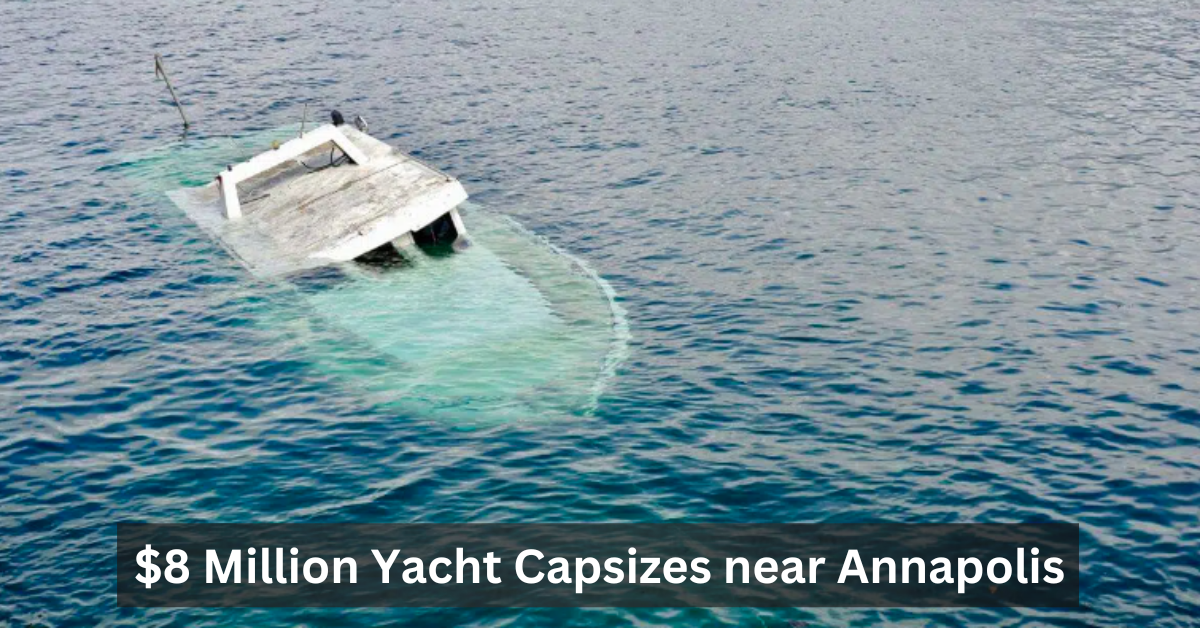$8 Million Yacht Capsizes near Annapolis: Luxury Yacht
The exact cause is still under investigation, but potential factors include weather conditions, structural failure, or human error. Regular yacht maintenance is crucial to prevent such incidents. The incident, which occurred on the Chesapeake Bay, highlighted the risks even high-end yachts face when navigating unpredictable waters. While the situation was quickly managed by local authorities, including the U.S. Coast Guard and Maryland Natural Resources Police, it served as a stark reminder of the importance of yacht safety and maritime responsibility.
The $8 Million Yacht Capsizes near Annapolis involved, known as the Lovebug Yacht, became the center of a rescue operation that saw swift response efforts from both professional teams and the local boating community. This incident sheds light on potential issues in yacht stability and environmental impact, urging the industry to reassess safety protocols, design vulnerabilities, and maintenance practices.
What Happened: A Detailed Account of the Capsizing Incident
The Lovebug Yacht was en route to a private event on the Rhode River when disaster struck. The yacht, an expensive and luxurious vessel, began experiencing difficulty as water started to breach the hull. This led to a capsizing that left the passengers stranded in the chilly waters of Chesapeake Bay. Fortunately, quick action by local boaters and the rapid response of the U.S. Coast Guard helped avert what could have been a far worse tragedy.
The incident unfolded in stages. Initially, the yacht faced a problem with water ingress, a common cause of yacht sinking, where water enters the vessel through damaged areas of the hull. Despite the best efforts of the yacht’s crew to address the issue, the situation escalated rapidly, forcing the boat to capsize. The Maryland Natural Resources Police swiftly arrived on the scene, coordinating a rescue operation that safely evacuated the crew and passengers from the overturned vessel.
The timeline of the rescue operations shows the effectiveness of marine safety protocols in place, but also underscores the importance of luxury yacht maintenance and the risks inherent in even the most well-designed vessels. The successful rescue operation was the result of expert coordination between the Coast Guard, local responders, and surrounding yacht owners.
Understanding Luxury Yachts: Why Safety Is Critical
Luxury yachts like the Lovebug are marvels of modern design, with exquisite interiors, powerful engines, and advanced technology. However, even the most cutting-edge superyachts face significant challenges in ensuring safety, especially when exposed to the unpredictable nature of open waters.
Features of a Typical Luxury Yacht
A typical luxury yacht is built for both comfort and performance, featuring state-of-the-art superyacht technology like stabilizing systems, advanced navigation, and automated systems for monitoring the yacht’s condition. These yachts can be over 100 feet in length, equipped with multiple decks, and can cost millions of dollars to design, manufacture, and maintain.
The issue, however, is that luxury yacht design vulnerabilities can sometimes expose the vessels to stability issues, particularly in rough waters or extreme weather. Despite these sophisticated features, yacht owners need to be aware of maintenance challenges and design flaws that could lead to accidents.
Common Causes of Yacht Accidents
Common causes of yacht accidents include structural failure, water ingress, engine failure, or human error. The Lovebug Yacht incident points to the possibility of either a design flaw or damage that allowed water to enter the hull, destabilizing the yacht. Ensuring yacht stability through proper design and regular maintenance is crucial for preventing such incidents.
The Lovebug Yacht: Background and Key Details
The Lovebug Yacht, a high-value vessel valued at $8 million, was designed by renowned luxury yacht manufacturers. This superyacht was built with the latest maritime technology, offering unparalleled comfort and speed. The design and capabilities of the yacht were intended for luxury charters and private cruising, catering to high-net-worth individuals who value both style and performance.
Design, Size, and Capabilities of the Yacht
Measuring over 100 feet, the Lovebug was built with top-tier materials and designed for long-distance cruising. It boasted impressive features such as a spacious sun deck, luxurious cabins, and cutting-edge navigation equipment. Despite its state-of-the-art design, the incident raised concerns about potential vulnerabilities in the hull and the challenges faced by even the most prestigious yacht manufacturers.
Owner and Crew Details
Though the identity of the yacht’s owner has not been publicly disclosed, the crew members were experienced professionals who had undergone rigorous yacht crew training. The incident revealed that even with an experienced crew at the helm, the maritime risks inherent in large vessels can still lead to catastrophic events.
The Chesapeake Bay: A Hazardous Waterscape for Yachts
Chesapeake Bay, the location of the Lovebug Yacht accident, presents unique challenges to yachts. The bay’s geography and maritime risks create a potentially hazardous environment for even the most skilled mariners.
Geography and Maritime Risks of Chesapeake Bay
Chesapeake Bay, one of the largest estuaries in the U.S., is known for its unpredictable weather patterns and shifting tides. The area has shallow waters, and complex currents, and is prone to sudden weather changes. These environmental factors can contribute to yacht stability issues, especially for larger vessels like superyachts, which are more susceptible to the forces of wind and water.
Unique Environmental Factors Affecting Yacht Stability
The bay is also home to numerous obstacles, such as submerged rocks and shifting sandbars, which pose additional risks. This makes yacht maintenance particularly important, as vessels need to be equipped to handle these environmental challenges, including water ingress and vessel hull damage that can occur when navigating such an environment.
What Caused the Capsizing? Investigating the Potential Causes
The Lovebug capsizing left many questioning the cause of the incident. Was it weather-related, a structural failure, or a result of human error? While the investigation is still ongoing, several potential causes have been discussed by maritime experts.
Possible Reasons for the Capsizing: Weather, Structural Failure, or Human Error
Maritime experts point to a combination of weather and potential vessel hull damage as contributing factors. Chesapeake Bay’s unpredictable weather patterns, coupled with a possible structural failure, may have led to the yacht taking on water, destabilizing the vessel. Another consideration is human error, such as misjudging weather conditions or failing to react quickly enough to signs of instability.
Importance of Regular Yacht Maintenance
This incident also highlights the importance of luxury yacht maintenance. Regular checks and maintenance are vital to ensuring that the vessel’s stabilizers, engines, and hull remain in good condition. Any compromise in these areas can lead to dangerous outcomes, as seen with the Lovebug Yacht.
Rescue Operations and Emergency Response: A Coordinated Effort
When the Lovebug Yacht capsized, it was the quick-thinking local boaters and the U.S. Coast Guard that made the difference. Their rescue operation was an exemplary example of how fast response times and effective coordination can save lives in maritime disasters.
How Local Boaters and the U.S. Coast Guard Responded
Once the capsizing was reported, nearby vessels immediately began yacht sinking rescue operations. The U.S. Coast Guard, a crucial player in the rescue operations Annapolis, quickly mobilized to secure the scene. Their ability to reach the site rapidly and coordinate with local responders helped ensure that all passengers were rescued without significant injury.
Role of the Maryland Natural Resources Police
The Maryland Natural Resources Police played a vital role in ensuring that the environmental risks were minimized, providing support with oil boom containment to prevent potential damage to the marine ecosystems of Chesapeake Bay.
Environmental Impacts of a Capsized Yacht
A capsized yacht can have devastating consequences for the environment. The Lovebug incident brought attention to the potential superyacht environmental risks posed by such accidents, particularly the threat of oil spills and other pollutants entering the bay’s delicate ecosystems.
Potential Risks to the Chesapeake Bay Ecosystem
The Chesapeake Bay is home to various species of fish, birds, and marine life that are at risk from oil leaks or other pollutants. The Chesapeake Bay Foundation and other environmental organizations acted swiftly, employing oil booms and other techniques to mitigate damage.
Efforts to Contain Fuel Spills Using Oil Booms
Oil booms and marine safety protocols were essential in containing the environmental damage. The Coast Guard response was crucial in preventing a larger ecological disaster and ensuring that the situation was handled with the utmost care for the bay’s fragile ecosystem.
Maritime Safety and Technology: Preventing Future Accidents
Advancements in superyacht technology have the potential to prevent future accidents like the Lovebug capsizing. Enhanced stability systems, automated monitoring of hull integrity, and real-time weather tracking are just a few examples of how luxury yacht manufacturers can improve safety.
Innovations in Yacht Design and Stability
As yacht technology continues to evolve, luxury yacht design companies such as Benetti and Azimut are integrating advanced stabilizers, sensors, and AI-driven systems to enhance stability. These innovations can reduce the risk of capsizing and improve the overall safety of luxury yachts.
Upcoming Changes in Maritime Regulations
Given the growing concerns about luxury yacht safety and environmental protection, regulatory bodies are likely to enforce stricter standards for yacht maintenance, design, and emergency preparedness. The yacht industry safety standards will continue to evolve to keep pace with these new challenges.
Lessons Learned: What Can the Luxury Yacht Industry Do Better?
The Lovebug Yacht capsizing underscores the need for a reassessment of the luxury yacht industry’s approach to safety and environmental impact. Improved luxury yacht maintenance challenges and better crew training are essential to reducing risks.
How the Industry Can Improve to Reduce Risks
The industry can take proactive steps to enhance luxury yacht safety by investing in more durable materials, refining hull designs to resist damage, and implementing more comprehensive maintenance schedules.
Sustainability and Long-Term Environmental Protection
Furthermore, embracing ecological disaster prevention in yachting and collaborating with environmental organizations to reduce the carbon footprint of yachts could help ensure a more sustainable future for the industry.
Conclusion
The capsizing of the Lovebug $8 Million Yacht Capsizes near Annapolis was a shocking event that demonstrated the inherent risks of even the most luxurious vessels. However, it also highlighted the strength of maritime safety systems and the dedication of first responders. As the yacht industry continues to innovate and evolve, it is crucial to prioritize safety, environmental responsibility, and the well-being of all involved.
Who responded to the yacht capsizing near Annapolis?
The U.S. Coast Guard, Maryland Natural Resources Police, and local boaters played key roles in rescuing the crew and containing the situation.
What is the environmental impact of a capsized yacht?
A capsized yacht can pose risks to marine ecosystems, including potential fuel spills. Efforts, such as using oil booms, are made to mitigate these environmental threats.
How can yacht owners prevent capsizing accidents?
Regular maintenance, understanding weather conditions, ensuring proper crew training, and using modern safety technology can significantly reduce the risk of accidents.
What are the safety standards for luxury yachts?
Luxury yachts are designed with advanced safety features, but adhering to industry safety standards and having a well-trained crew are essential to ensuring vessel stability and crew protection.
Stay in touch to get more updates & alerts on EroMe! Thank you

